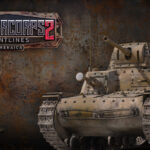You tried your best, but it’s not enough. Often you are greeted by mission failure, and you can see why when the scoreboard shows you lose more men and equipment than your enemy. Worst of all, you’re not sure why. Fret not; below are the top 10 tips to help you to be a better armchair general by applying some core principles from the real-world military. Remember, these tips aren’t a guarantee of success, but they can certainly help you improve your playthrough.
Each point is supported by a screenshot from Flashpoint Campaign Southern Storm by On Target Simulations Published by Slitherine Ltd.
1) Scouting & Gathering intelligence: First and foremost, accurate, relevant, and timely intel should be obtained before any planning or movement happens. Having eyes and ears on the battlefield is critical in determining the enemy’s position and strength. Do not send your main assault units into the fog of war without obtaining essential intel about the terrain, possible enemy locations, and strong points. Identify critical terrains like hills or bridges and potential kill zones. This is a fundamental tip for any armchair general and will save you frustration while improving your essential ability on the battlefield.

2) Know your army composition: Are you commanding an infantry battalion or an armored brigade? Understand the types of units you have and their capabilities. What kind of support do you have to help to reach your objectives? If you don’t know what your army is capable of or its specialization, you may not wield it effectively or may even doom it. Viewing your army as a whole and integrating different combat arms of a military to achieve mutually complementary effects is crucial in warfare. For example, using infantry and armor in an urban environment where each supports the other is vital.

3) Study the terrain: Terrain can significantly impact the outcome of a battle. Suppose you don’t understand how the terrain affects movement, line of sight, cover, and other factors. In that case, you won’t be able to make informed decisions about how to position your forces or which key terrain to prioritize taking to maximize its advantage over the enemy. Other elements like night/day cycles and weather can also have lasting effects on the fog of war or the performance of armies, especially when moving through muddy terrain or under torrential rains.

4) Understand the objectives: Don’t just move the frontline towards your enemy; take the time to consider all primary and secondary objectives in any battle. Build your strategies and approach based on the goals. Remember always to take the path of least resistance. Understanding the purposes of the battle is critical to developing effective strategies. If you don’t know what you’re trying to accomplish, you won’t be able to make informed decisions about how to achieve your goals.

5) Engage in effective planning: Once you have your objectives, start planning how to achieve them—considering your army’s strength and support. Develop relevant strategies and tactics to overwhelm your enemy or get to the objectives effectively. Planning is tied to coordinating your forces effectively or responding to unexpected events during the battle. Remember that no plan survives enemy contact. Always expect the unexpected, and you will be a better armchair general.

6) Logistics and Supply: No matter your plans, always remember the boring side of warfare, logistics, and supply. How will you ensure supply lines aren’t broken while you spearhead into enemy territory? Are there enough ammunition and rations for your troops, gas for your tanks? Ponder these questions when planning for anything. Remember that you are playing the long game when you respect the importance of logistics in any army. After all, the army marches on their stomach.

7) Manage resources effectively: Commit only enough troops and resources to achieve objectives. Having reserve units is contingent on changing situations. Hence, effective resource management, including troops, supplies, and equipment, is critical to success in any battle. If you don’t manage your resources effectively, you may run out of supplies, leave yourself vulnerable to attacks, or miss opportunities to gain an advantage.

8) Do not overreact: This is a common mistake. Often overreacting to the first move from your opponent can mean falling right into their trap or allowing them to control the situation instead of vice versa. Remember there’s reason for contingency plans, and anticipating your opponent’s moves will help you better accommodate their strategies. Be confident and stick to your plans.

9) Adapt to changing circumstances: Battles are dynamic and constantly evolving. If you don’t adapt to changing circumstances, you may be disadvantaged or miss opportunities to gain an advantage. Don’t be afraid to modify strategies midway or lend other units to assist in capturing an objective if it means sacrificing secondary objectives but strengthening your resolve on closing a primary objective.

10) PIck up a history book: Lastly, study older real-world battles and the generals that commanded the armies in those battles. What strategies were used? What would you have done to change the outcome of the battle? It’s safe to assume most wargamers are also military history enthusiasts and are familiar with most historical conflicts. However, you can dive deeper by playing out historical scenarios with your own decisions replaced. Flashpoint Campaign Southern Storm has fantastic operational scenarios ready for the eager armchair general to try their tactics on.

These tips may not be detailed but they are just principles that anyone can follow and can be applied to most wargames. I myself am always improving and these are simply some of the lessons I learned along the way while enjoying the simulation of wargames and the splendor of planning and witnessing your very own plan unfold before your eyes as hundreds if not thousands of troops’ fate lie in your hands.






